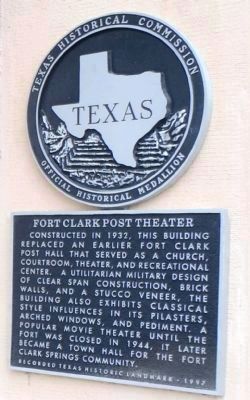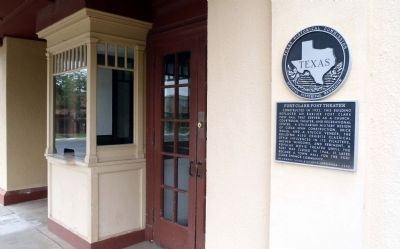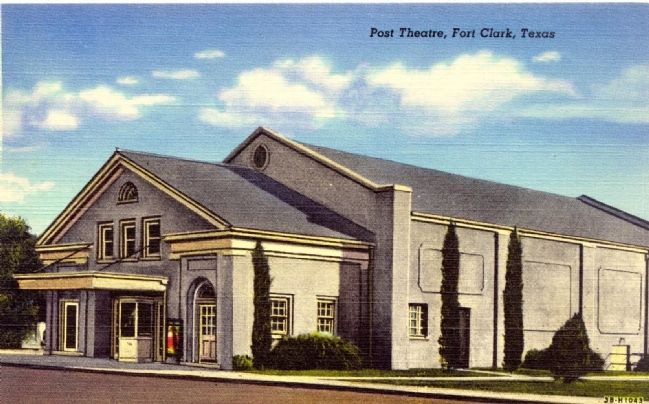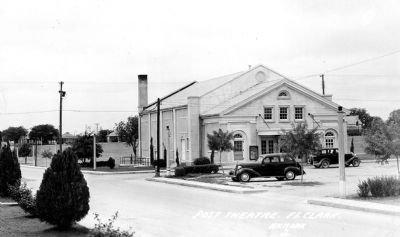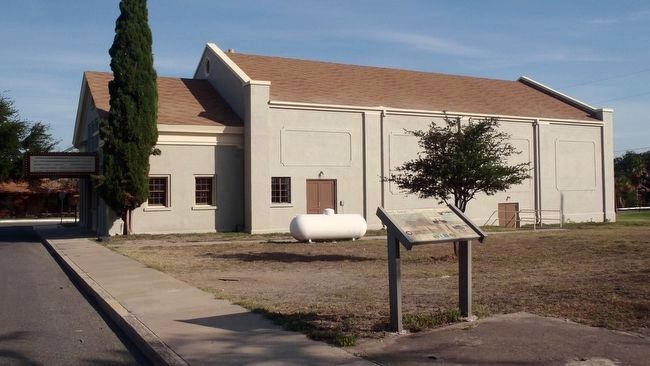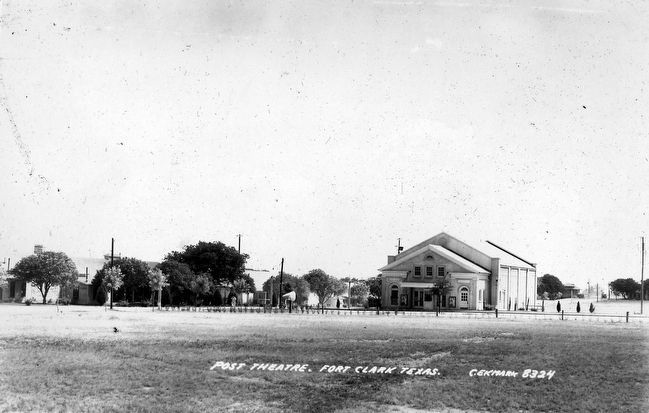Near Brackettville in Kinney County, Texas — The American South (West South Central)
Fort Clark Post Theater
Constructed in 1932, this building replaced an earlier Fort Clark Post Hall that served as a church, courtroom, theater, and recreational center. A utilitarian military design of clear span construction, brick walls, and a stucco veneer, the building also exhibits classical style influences in its pilasters, arched windows, and pediment. A popular movie theater until the fort was closed in 1944, it later became a town hall for the Fort Clark Springs community.
Erected 1997 by Texas Historical Commission. (Marker Number 12002.)
Topics and series. This historical marker is listed in this topic list: Notable Buildings. In addition, it is included in the Art Deco series list. A significant historical year for this entry is 1932.
Location. 29° 18.302′ N, 100° 25.253′ W. Marker is near Brackettville, Texas, in Kinney County. Marker is at the intersection of Patton Road and Fort Clark Road, on the right when traveling east on Patton Road. Marker is located on Fort Clark Springs in the Fort Clark National Register Historic District and is accessible to the public. Touch for map. Marker is in this post office area: Brackettville TX 78832, United States of America. Touch for directions.
Other nearby markers. At least 8 other markers are within walking distance of this marker. 1873 Infantry Barracks (within shouting distance of this marker); Palisado Building Kitchen / Mess Room (about 300 feet away, measured in a direct line); Remolino Raid (about 300 feet away); Married Officers' Quarters 8-9 (about 500 feet away); Officers' Row Quarters (about 500 feet away); Officers Quarters 2-3 and 4 (about 500 feet away); New Cavalry Barracks (about 600 feet away); Fort Clark Guardhouse (about 600 feet away). Touch for a list and map of all markers in Brackettville.
Regarding Fort Clark Post Theater. The post hose house, a small frame storage building for fire fighting equipment, occupied this site in the 19th century followed in the early 20th century by a Y.M.C.A. building and then a service club. Panoramic photos from the 1920’s show an outdoor screen behind the Service Club so the soldiers could experience “moving picture shows.” As the times changed the Army made a conscious effort to keep in step with American society by providing soldiers with modern recreation and entertainment facilities, often in a vain attempt to prevent the soldiers from patronizing the seedier establishments in Brackettville. To serve that noble purpose the Post Theater was built in 1932. Its design is the classic “movie house” art deco style of the 1930s and it is the only steel frame structure built by the Army on the fort. The theater featured refrigerated air, compressed seaweed acoustical tile walls, and seating for over 400 soldiers. The 5th Cavalry band frequently played outside in the evening to attract troopers to the show. The theater served the garrison for only 12 years until Fort Clark quietly and unceremoniously slipped into history and out of active service on August 28, 1944, when the last soldiers departed. The Corps of Engineers served as caretakers until the venerable post was declared surplus and sold for salvage to the Texas Railway Equipment Company in October of 1946. The new civilian owners tore down the nearly 1,500 wood frame World War II buildings. However, through considerable foresight, the historic 19th and early 20th century structures and stone buildings were spared the wrecking ball. During the 1950’s and 60’s the Brown Foundation operated the grounds as the Fort Clark Guest Ranch and removed the theater’s projection equipment, screen, and seats. The floor was terraced but the stage area was retained. In 1971 the property was sold to a private developer who created a gated community and homeowners association, which operates today as the Fort Clark Springs Association. The Post Theater was renamed the Town Hall and used for assemblies, dances, and theatricals, in fact everything but movies. The Post Theater was designated a Recorded Texas Historic Landmark in 1997 and is still in use for social events and by Fort Clark’s Old Quarry Society for the Performing Arts for stage productions.
The Recorded Texas Historic Landmark (RTHL) designation is awarded to historic structures deemed worthy of preservation for their architectural integrity and historical associations. Recorded Texas Historic Landmark is the highest honor the state can bestow on historic structures in Texas. Properties so designated are afforded a measure of legal protection and become part of the recorded history of the state’s built environment. Additionally, the Post Theater is a contributing structure to the Fort Clark Historic District, listed in the National Register of Historic Places December 6, 1979.
Also see . . . Military Architecture at Fort Clark, A Guide to the Texas Historic Landmark.
Thomas Jefferson recognized that a morsel of genuine history is a thing so rare as to be always valuable. The Fort Clark Historic District, in Kinney County, Texas, is far more than a morsel. It is a full-course buffet of U.S. Army architecture, with more than one hundred well-preserved structures from the nineteenth and twentieth centuries, some built to Quartermaster model plans, and many the only remaining examples in the nation. While most other Texas Indian War-era forts are long abandoned and reduced to nothing more than stark chimneys on the prairie, Fort Clark's wide-ranging military architecture has survived virtually unchanged. Author William Haenn surveys the landmark site that represents nearly a century of active service to Texas and the nation.(Submitted on February 8, 2024, by William F Haenn of Fort Clark (Brackettville), Texas.)
Additional keywords. Army Architecture
Credits. This page was last revised on February 10, 2024. It was originally submitted on May 1, 2012, by William F Haenn of Fort Clark (Brackettville), Texas. This page has been viewed 834 times since then and 37 times this year. Last updated on May 17, 2012, by William F Haenn of Fort Clark (Brackettville), Texas. Photos: 1. submitted on May 2, 2012, by William F Haenn of Fort Clark (Brackettville), Texas. 2, 3, 4. submitted on May 1, 2012, by William F Haenn of Fort Clark (Brackettville), Texas. 5, 6. submitted on October 28, 2015, by William F Haenn of Fort Clark (Brackettville), Texas. • Craig Swain was the editor who published this page.
